Bob Hope
Bob Hope KBE, KC*SG, KSS (born Leslie Townes Hope; May 29, 1903 – July 27, 2003) was a British-American stand-up comedian,[2] vaudevillian, actor, singer, dancer, athlete, and author. With a career that spanned nearly 80 years, Hope appeared in more than 70 short and feature films, with 54 feature films with Hope as star, including a series of seven "Road" musical comedy movies with Bing Crosby as Hope's top-billed partner.
Bob Hope KBE, KC*SG, KSS | |
|---|---|
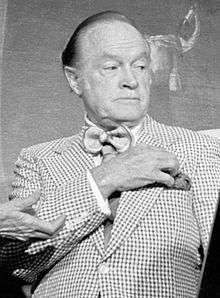 Hope in 1978 | |
| Born | Leslie Townes Hope May 29, 1903 |
| Died | July 27, 2003 (aged 100) Toluca Lake, California, U.S.
|
Buried | San Fernando Mission Cemetery, U.S. |
| Other names | Les Hope Packy East |
| Occupation |
|
| Years active | 1919–1997 |
| Spouse(s) | Grace Louise Troxell (m. 1933; div. 1934) Dolores Reade (m. 1934) |
| Children | 4 |
| Relatives | Jack Hope (brother) |
| Awards | List of awards and nominations received by Bob Hope |
| Boxing career | |
| Statistics | |
| Weight(s) | Super Featherweight (128 lb) |
| Height | 5 ft 10 in (178 cm) |
| Reach | 72 in (183 cm) |
| Boxing record | |
| Wins | 3 |
| Losses | 1 (see Bob Hope boxing record) |
| Musical career | |
| Genres |
|
| Instruments | Vocals |
| Website | bobhope |
| Signature | |
In addition to hosting the Academy Awards show 19 times, more than any other host, he appeared in many stage productions and television roles, and was the author of 14 books. The song "Thanks for the Memory" was his signature tune. Hope was born in the Eltham district of southeast London, UK, arrived in the United States of America with his family at the age of four, and grew up in the Cleveland, Ohio, area.
After a brief career as a boxer in the late 1910s, he began his career in show business in the early 1920s, initially as a comedian and dancer on the vaudeville circuit, before acting on Broadway. Hope began appearing on radio and in films starting in 1934. He was praised for his comedic timing, specializing in one-liners and rapid-fire delivery of jokes which often were self-deprecating. He helped establish modern American stand-up comedy.[2]
Celebrated for his long career performing in United Service Organizations (USO) shows to entertain active duty American military personnel, making 57 tours for the USO between 1941 and 1991, Hope was declared an honorary veteran of the U.S. Armed Forces in 1997 by an act of the United States Congress.[3] He appeared in numerous specials for NBC television starting in 1950, and was one of the first users of cue cards.
Hope participated in the sports of golf and boxing and owned a small stake in his hometown baseball team, the Cleveland Indians. Hope retired in 1997, and died at the age of 100 in 2003, at his home in the Toluca Lake neighborhood of Los Angeles.
Early years
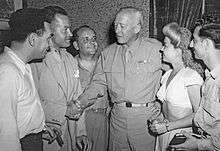
Leslie Townes Hope was born in Eltham, County of London[1] (now part of the Royal Borough of Greenwich), in a terraced house on Craigton Road in Well Hall[4][5] where there is now a blue plaque in his memory.[6] He was the fifth of seven sons of an English father, William Henry Hope, a stonemason from Weston-super-Mare, Somerset, and a Welsh mother, Avis (née Townes), a light opera singer from Barry, Vale of Glamorgan,[7] who later worked as a cleaner. William and Avis married in April 1891 and lived at 12 Greenwood Street in Barry before moving to Whitehall, Bristol, and then to St George, Bristol. In 1908, the family emigrated to the United States, sailing aboard the SS Philadelphia. They passed through Ellis Island, New York on March 30, 1908, before moving on to Cleveland, Ohio.[8]
From age 12, Hope earned pocket money by busking—public performing to solicit contributions (frequently on the streetcar to Luna Park), singing, dancing, and performing comedy.[9] He entered numerous dancing and amateur talent contests as Lester Hope, and won a prize in 1915 for his impersonation of Charlie Chaplin.[10] For a time, he attended the Boys' Industrial School in Lancaster, Ohio, and as an adult donated sizable sums of money to the institution.[11] Hope had a brief career as a boxer in 1919, fighting under the name Packy East. He had three wins and one loss, and he participated in a few staged charity bouts later in life.[12]
Hope worked as a butcher's assistant and a lineman in his teens and early 20s. He also had a brief stint at Chandler Motor Car Company. In 1921, while assisting his brother Jim in clearing trees for a power company, he was sitting atop a tree that crashed to the ground, crushing his face; the accident required Hope to undergo reconstructive surgery, which contributed to his later bizarrely distinctive appearance.[13]
Deciding on a show business career, Hope and his girlfriend at the time signed up for dancing lessons. Encouraged after they performed in a three-day engagement at a club, Hope formed a partnership with Lloyd Durbin, a friend from the dancing school.[14] Silent film comedian Fatty Arbuckle saw them perform in 1925 and found them work with a touring troupe called Hurley's Jolly Follies. Within a year, Hope had formed an act called the Dancemedians with George Byrne and the Hilton Sisters, conjoined twins who performed a tap dancing routine on the vaudeville circuit. Hope and Byrne had an act as Siamese twins as well, and danced and sang while wearing blackface until friends advised Hope he was funnier as himself.[15]
In 1929, Hope informally changed his first name to "Bob." In one version of the story, he named himself after race car driver Bob Burman.[16] In another, he said he chose the name because he wanted a name with a "friendly 'Hiya, fellas!' sound" to it.[17] In a 1942 legal document, his legal name is given as Lester Townes Hope; it is unknown if this reflects a legal name change from Leslie.[18] After five years on the vaudeville circuit, Hope was "surprised and humbled" when he failed a 1930 screen test for the French film production company Pathé at Culver City, California.[19]
During a short stint, Hope became a part owner of the Riverside International Raceway in (what is now) Moreno Valley, California, along with Los Angeles Rams co-owner Ed Levy and oil tycoon Ed Pauley for $800,000 (adjusted to $6,951,567.57 in 2020) and made Les Richter President of the raceway. [20]
Career
In the early days, Hope's career included appearances on stage in vaudeville shows and Broadway productions. He began performing on the radio in 1934 mostly with NBC radio, and switched to television when that medium became popular in the 1950s. He began doing regular TV specials in 1954,[21] and hosted the Academy Awards nineteen times from 1939 through 1977.[22] Overlapping with this was his movie career, spanning 1934 to 1972, and his USO tours, which he conducted from 1941 to 1991.[23][24]
Film
Hope signed a contract with Educational Pictures of New York for six short films. The first was a comedy, Going Spanish (1934). He was not happy with it, and told newspaper gossip columnist Walter Winchell, "When they catch [bank robber] Dillinger, they're going to make him sit through it twice."[25] Although Educational Pictures dropped his contract, he soon signed with Warner Brothers, making movies during the day and performing in Broadway shows in the evenings.[26]
Hope moved to Hollywood when Paramount Pictures signed him for the 1938 film The Big Broadcast of 1938, also starring W. C. Fields. The song "Thanks for the Memory", which later became his trademark, was introduced in the film as a duet with Shirley Ross, accompanied by Shep Fields and his orchestra.[27] The sentimental, fluid nature of the music allowed Hope's writers—he depended heavily upon joke writers throughout his career[28]—to later create variations of the song to fit specific circumstances, such as bidding farewell to troops while on tour or mentioning the names of towns in which he was performing.[29]
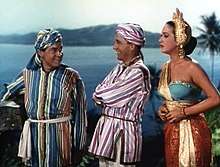
As a film star, Hope was best known for such comedies as My Favorite Brunette and the highly successful "Road" movies in which he starred with Bing Crosby and Dorothy Lamour. The series consists of seven films made between 1940 and 1962: Road to Singapore (1940), Road to Zanzibar (1941), Road to Morocco (1942), Road to Utopia (1946), Road to Rio (1947), Road to Bali (1952), and The Road to Hong Kong (1962). Hope had seen Lamour performing as a nightclub singer in New York,[30] and invited her to work on his United Service Organizations (USO) tours of military facilities. Lamour sometimes arrived for filming prepared with her lines, only to be baffled by completely rewritten scripts or ad lib dialogue between Hope and Crosby.[31] Hope and Lamour were lifelong friends, and she remains the actress most associated with his film career although he made movies with dozens of leading ladies, including such luminaries as Katharine Hepburn, Paulette Goddard, Hedy Lamarr, Lucille Ball, Rosemary Clooney, Jane Russell, and Elke Sommer.[32]
From their first meeting in 1932, Hope and Crosby teamed not only for the "Road" pictures, but for countless stage, radio, and television appearances and many brief movie appearances together over the decades [33] until Crosby's death in 1977. Although the two invested together in oil leases and other business ventures, worked together frequently, and lived near each other, they rarely saw each other socially.[34]
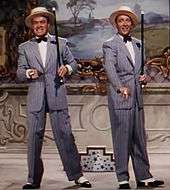
After the release of Road to Singapore (1940), Hope's screen career took off, and he had a long and successful run. After an 11-year hiatus from the "Road" genre, he and Crosby reteamed for The Road to Hong Kong (1962), starring the 28-year-old Joan Collins in place of Lamour, whom Crosby thought was too old for the part.[35] They had planned one more movie together in 1977, The Road to the Fountain of Youth, but filming was postponed when Crosby was injured in a fall, and the production was cancelled when he suddenly died of heart failure that October.[36]
Hope starred in 54 theatrical features between 1938 and 1972,[37] as well as cameos and short films. Most of his later movies failed to match the stratospheric success of his 1940s efforts. He was disappointed with his appearance in Cancel My Reservation (1972), his last starring film, and the movie was poorly received by critics and filmgoers.[38] Though his career as a film star effectively ended in 1972, he did make a few cameo film appearances into the 1980s.
Hope was host of the Academy Awards ceremony 19 times between 1939 and 1977. His supposedly-feigned desire for an Oscar became part of his act.[39] While introducing the 1968 telecast, he quipped, "Welcome to the Academy Awards, or, as it's known at my house, Passover."[40] Although he was never nominated for an Oscar, the Academy of Motion Picture Arts and Sciences honored him with four honorary awards, and in 1960 presented him with the Jean Hersholt Humanitarian Award, given each year as part of the Oscars ceremony.
Broadcasting
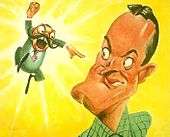
Hope's career in broadcasting began on radio in 1934. His first regular series for NBC Radio was the Woodbury Soap Hour in 1937, on a 26-week contract. A year later, The Pepsodent Show Starring Bob Hope began, and Hope signed a ten-year contract with the show's sponsor, Lever Brothers. He hired eight writers and paid them out of his salary of $2,500 a week. The original staff included Mel Shavelson, Norman Panama, Jack Rose, Sherwood Schwartz, and Schwartz's brother Al. The writing staff eventually grew to fifteen.[41] The show became the top radio program in the country. Regulars on the series included Jerry Colonna and Barbara Jo Allen as spinster Vera Vague. Hope continued his lucrative career in radio into the 1950s, when radio's popularity began being overshadowed by the upstart television medium.[42][43]
On April 26, 1970, CBS released the television special Raquel! directed by David Winters, in which he was a guest. It starred Raquel Welch, and other guests included Tom Jones and John Wayne.[44] On the day of the premiere, the show received a 51% share on the National ARB Ratings and an impressive Overnight New York Nielsen Rating of 58% share.[45][46]
NBC comedy specials
Hope did many specials for the NBC television network in the following decades, beginning in April 1950. He was one of the first people to use cue cards. The shows often were sponsored by Frigidaire (early 1950s), General Motors (1955–61), Chrysler (1963–73), and Texaco (1975–85).[47] Hope's Christmas specials were popular favorites and often featured a performance of "Silver Bells"—from his 1951 film The Lemon Drop Kid—done as a duet with an often much younger female guest star such as Olivia Newton-John, Barbara Eden, and Brooke Shields,[48] or with his wife Dolores, a former singer with whom he dueted on two specials. Hope's 1970 and 1971 Christmas specials for NBC—filmed in Vietnam in front of military audiences at the height of the war—are on the list of the Top 46 U.S. network prime-time telecasts. Both were seen by more than 60 percent of the U.S. households watching television.[49]
The Adventures of Bob Hope
Beginning in early 1950, Hope licensed rights to publish a celebrity comic book titled The Adventures of Bob Hope to National Periodical Publications, alias DC Comics. The comic, originally featuring publicity stills of Hope on the cover, was entirely made up of fictional stories, eventually including fictitious relatives, a high school taught by movie monsters, and a superhero called Super-Hip. It was published intermittently, and continued publication through issue #109 in 1969. Illustrators included Bob Oksner and (for the last four issues) Neal Adams.
USO involvement
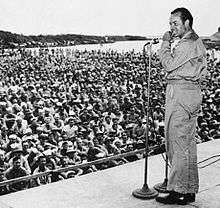
While aboard the RMS Queen Mary when World War II began in September 1939, Hope volunteered to perform a special show for the passengers, during which he sang "Thanks for the Memory" with rewritten lyrics.[50] He performed his first USO show on May 6, 1941, at March Field in California,[51] and continued to travel and entertain troops for the rest of World War II, later during the Korean War, the Vietnam War, the third phase of the Lebanon Civil War, the latter years of the Iran–Iraq War, and the 1990–91 Persian Gulf War.[24] His USO career lasted a half-century during which he headlined 57 times.[24]
He had a deep respect for the men and women who served in the military, and this was reflected in his willingness to go anywhere to entertain them.[52] However, during the highly controversial Vietnam War, Hope had trouble convincing some performers to join him on tour. Anti-war sentiment was high, and his pro-troop stance made him a target of criticism from some quarters. Some shows were drowned out by boos, others were listened to in silence.[53]
The tours were funded by the U.S. Department of Defense, Hope's television sponsors, and by NBC, the network that broadcast the television specials created after each tour from footage shot on location. However, the footage and shows were owned by Hope's own production company, which made them very lucrative ventures for him, as outlined by writer Richard Zoglin in his 2014 biography "Hope: Entertainer of the Century."
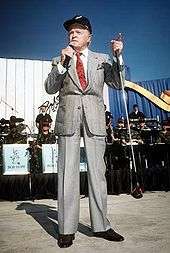
Hope sometimes recruited his own family members for USO travel. His wife, Dolores, sang from atop an armored vehicle during the Desert Storm tour, and granddaughter Miranda appeared alongside him on an aircraft carrier in the Indian Ocean.[52] Of Hope's USO shows in World War II, novelist John Steinbeck, who then was working as a war correspondent, wrote in 1943:
"When the time for recognition of service to the nation in wartime comes to be considered, Bob Hope should be high on the list. This man drives himself and is driven. It is impossible to see how he can do so much, can cover so much ground, can work so hard, and can be so effective. He works month after month at a pace that would kill most people."[54]
For his service to his country through the USO, he was awarded the Sylvanus Thayer Award by the United States Military Academy at West Point in 1968.[55] A 1997 act of Congress signed by President Bill Clinton named Hope an "Honorary Veteran." He remarked, "I've been given many awards in my lifetime, but to be numbered among the men and women I admire most is the greatest honor I have ever received."[56] In an homage to Hope, comedian/TV host Stephen Colbert carried a golf club on stage during the single week of USO performances he taped for his TV show The Colbert Report during the 2009 season.[57]
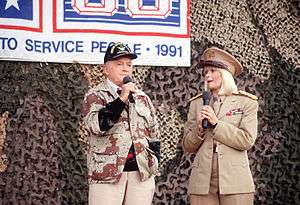
Theater
Hope's first Broadway appearances, in 1927's The Sidewalks of New York and 1928's Ups-a-Daisy, were minor walk-on parts.[58] He returned to Broadway in 1933 to star as Huckleberry Haines in the Jerome Kern / Dorothy Fields musical Roberta.[59] Stints in the musicals Say When, the 1936 Ziegfeld Follies with Fanny Brice, and Red, Hot and Blue with Ethel Merman and Jimmy Durante followed.[60] Hope reprised his role as Huck Haines in a 1958 production of Roberta at The Muny Theater in Forest Park in St. Louis, Missouri.[61]
Additionally, Hope rescued the Eltham Little Theatre in England from closure by providing funds to buy the property. He continued his interest and support, and regularly visited the facility when in London. The theater was renamed in his honor in 1982.[62]
Later appearances
In 1992 Hope made a guest appearance as himself on the animated Fox series The Simpsons, in the episode titled "Lisa the Beauty Queen" (season 4, episode 4).[63] His 90th birthday television celebration in May 1993, Bob Hope: The First 90 Years, won an Emmy Award for Outstanding Variety, Music Or Comedy Special.[64] Toward the end of his career, worsening vision problems rendered him unable to read his cue cards.[65] In October 1996, he announced he was ending his 60-year contract with NBC, joking that he "decided to become a free agent."[66] His final television special, Laughing with the Presidents, was broadcast in November 1996, with host Tony Danza helping him present a personal retrospective of presidents of the United States known to Hope, a frequent White House visitor over the years. However, the special received poor reviews.[67] Following a brief appearance at the 50th Primetime Emmy Awards in 1997, Hope made his last TV appearance in a 1997 commercial about the introduction of Big Kmart, and directed by Penny Marshall.[68]
Critical reception
Hope was widely praised for his comedy timing and his specialization in the use of one-liners and rapid-fire delivery of jokes. He was known for his style of self-deprecating jokes, first building himself up and then tearing himself down. He performed hundreds of times per year.[69] Such early films as The Cat and the Canary (1939) and The Paleface (1948) were financially successful and praised by critics,[70] and by the mid-1940s, with his radio program getting good ratings as well, he was one of the most popular entertainers in the United States.[71] When Paramount threatened to stop production of the "Road" pictures in 1945, they received 75,000 letters of protest.[72]
Hope had no faith in his skills as a dramatic actor, and his performances of that type were not as well received.[73] He had been well known in radio until the late 1940s; however, as his ratings began to slip in the 1950s, he switched to television and became an early pioneer of that medium.[48][74] He published several books, notably dictating to ghostwriters about his wartime experiences.[71]
Although Hope made an effort to keep his material up to date, he never adapted his comic persona or his routines to any great degree. As Hollywood began to transition to the "New Hollywood" era in the 1960s, he reacted negatively, such as when he hosted the 40th Academy Awards in 1968 and voiced his contempt by mocking the show's delay because of the assassination of Martin Luther King Jr. and condescendingly greeted attending younger actors on stage—such as Dustin Hoffman, who was 30 at the time—as children.[75] By the 1970s, his popularity was beginning to wane with military personnel and with the movie-going public in general.[76] However, he continued doing USO tours into the 1980s,[77] and continued to appear on television into the 1990s. Former First Lady Nancy Reagan, a close friend and frequent host to him at the White House, called Hope "America's most honored citizen and our favorite clown."[78]
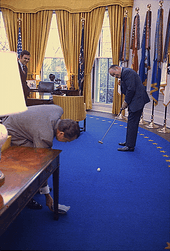
Hope was well known as an avid golfer, playing in as many as 150 charity tournaments a year.[79] Introduced to the game in the 1930s while performing in Winnipeg, Canada,[80] he eventually played to a four handicap. His love for the game—and the humor he could find in it—made him a sought-after foursome member. He once remarked that President Dwight D. Eisenhower gave up golf for painting: "Fewer strokes, you know."[81] He also was quoted as saying, "It's wonderful how you can start out with three strangers in the morning, play 18 holes, and by the time the day is over you have three solid enemies." [82]
A golf club became an integral prop for Hope during the standup segments of his television specials and USO shows. In 1978 he putted against the then-two-year-old Tiger Woods in a television appearance with the actor Jimmy Stewart on The Mike Douglas Show.[83]
The Bob Hope Classic, founded in 1960, made history in 1995 when Hope teed up for the opening round in a foursome that included Presidents Gerald Ford, George H.W. Bush, and Bill Clinton, the only time three U.S. presidents played in the same golf foursome.[84] The event, now known as the CareerBuilder Challenge, was one of the few PGA Tour tournaments that took place over five rounds, until the 2012 tournament when it was cut back to the conventional four.[85]
Hope had a heavy interest in sports beyond golf and his brief fling as a professional boxer in his youth. In 1946, he bought a small stake in the Cleveland Indians professional baseball team[86] and held it for most of the rest of his life.[87] He appeared on the June 3, 1963, cover of Sports Illustrated magazine wearing an Indians uniform,[88] and sang a special version of "Thanks for the Memory" after the Indians' last game at Cleveland Stadium on October 3, 1993.[89] He also bought a share with Bing Crosby of the Los Angeles Rams football team in 1947, but sold it in 1962.[90] He frequently used his television specials to promote the annual AP College Football All-America Team. The players would come onstage one by one and introduce themselves, then Hope, often dressed in a football uniform, would give a one-liner about the player or his school.[91]
Personal life
Marriages
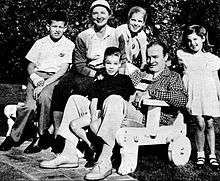
Hope's short-lived first marriage was to vaudeville partner Grace Louise Troxell (1912–1992), a secretary from Chicago, Illinois, who was the daughter of Edward and Mary (McGinnes) Troxell. They were married on January 25, 1933, in Erie, Pennsylvania, with Alderman Eugene Alberstadt officiating.[92][93] They divorced in November 1934.[94]
The couple had shared headliner status with Joe Howard at the Palace Theatre in April 1931, performing "Keep Smiling" and the "Antics of 1931."[95] The couple were working together at the RKO Albee, performing the "Antics of 1933" along with Ann Gillens and Johnny Peters in June of that year.[96] The following month, singer Dolores Reade joined Hope's vaudeville troupe and was performing with him at Loew's Metropolitan Theater. She was described as a "former Ziegfeld beauty and one of society's favorite nightclub entertainers, having appeared at many private social functions at New York, Palm Beach, and Southampton."[97]
His long marriage to Dolores (DeFina) Reade was fraught with ambiguities. As Richard Zoglin wrote in his 2014 biography Hope: Entertainer of the Century, "Bob and Dolores always claimed that they married in February 1934 in Erie, Pennsylvania. But at that time he was secretly married to his vaudeville partner Louise Troxell, after three years together on and off. I found divorce papers for Bob and Louise dated November 1934, so either Bob Hope was a bigamist or he lied about marrying Dolores in February that year. He had actually married Louise in January 1933 in Erie when they were traveling on the vaudeville circuit. When he claimed he had married Dolores in Erie he was miles away in New York, on Broadway. More intriguing, there is no record anywhere of his marriage to Dolores, if it happened. And there are no wedding photos, either. But he never forgot Louise and quietly sent her money in her later years."[94]
Dolores had been one of Hope's co-stars on Broadway in Roberta. The couple adopted four children: Linda (in 1939), Tony (1940), Kelly (1946), and Eleanora, known as Nora (1946). [98] From them, they had several grandchildren, including Andrew, Miranda, and Zachary Hope. Tony (as Anthony J. Hope) served as a presidential appointee in the George H. W. Bush and Clinton administrations and in a variety of posts under Presidents Gerald Ford and Ronald Reagan.[99] Bob and Dolores were also the legal guardians of Tracey, the youngest daughter of famous New York City bar owner Bernard "Toots" Shor and his wife, Marion "Baby" Shor.
In 1935, the couple lived in Manhattan. From 1937 until his death, Hope lived at 10346 Moorpark Street in Toluca Lake, California.[100]
Extramarital affairs
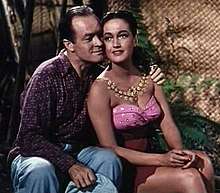
Hope had a reputation as a womanizer and continued to see other women throughout his marriage.[101] As Zoglin wrote in Hope: Entertainer of the Century, "Bob Hope had affairs with chorus girls, beauty queens, singers and showbiz wannabes through his 70s; he had a different girl on his arm every night. He was still having affairs into his 80s..."
As just one example among many, in 1949 while Hope was in Dallas on a publicity tour for his radio show, he met Barbara Payton, a contract player at Universal Studios, who at the time was on her own public relations jaunt. Shortly thereafter, Hope set up Payton in an apartment in Hollywood.[102] The arrangement soured as Hope was not able to satisfy Payton's definition of generosity and her need for attention.[103] Hope paid her off to end the affair quietly. Payton later revealed the affair in an article printed in July 1956 in the tell-all magazine Confidential.[104] "Hope was ... at times a mean-spirited individual with the ability to respond with a ruthless vengeance when sufficiently provoked."[105] His advisors counseled him to avoid further publicity by ignoring the Confidential exposé.[105] "Barbara's ... revelations caused a minor ripple ... and then quickly sank without causing any appreciable damage to Bob Hope's legendary career."[105]
According to Arthur Marx's 1993 Hope biography, The Secret Life of Bob Hope, Hope's subsequent long-term affair with actress Marilyn Maxwell was so open that the Hollywood community routinely referred to her as "Mrs. Bob Hope".[106]
Rosemarie Frankland was a beauty queen (Miss World 1961) who according to Richard Zoglin's book "Hope: Entertainer of the Century" took part in a 30-year affair with Hope. He said she was "the great love of his life." [107]
Hope's infidelities are a significant part of the plot of the upcoming 2020 comedy-drama feature film Misbehaviour about the Women's Liberation protests at the Miss World 1970 competition that Hope hosted starring Keira Knightley, Jessie Buckley and Greg Kinnear as Hope.[108]
Vision philanthropy
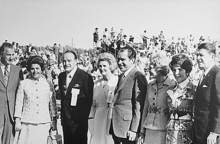
Hope, who suffered from vision problems for much of his adult life, served as an active honorary chairman on the board of Fight for Sight, a nonprofit organization in the United States which funds medical research in vision and ophthalmology. He hosted its Lights On telecast in 1960 and donated $100,000 to establish the Bob Hope Fight for Sight Fund.[109] Hope recruited numerous top celebrities for the annual "Lights On" fundraiser. As an example, he hosted boxing champion Joe Frazier, actress Yvonne De Carlo, and singer-actor Sergio Franchi as headliners for the April 25, 1971, show at Philharmonic Hall in Milwaukee.[110]
Material loss
On June 25, 2019, The New York Times Magazine listed Bob Hope among hundreds of artists whose material was reportedly destroyed in the 2008 Universal fire.[111]
His later years
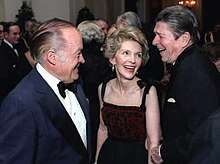

Hope continued an active entertainment career past his 75th birthday, concentrating on his television specials and USO tours.
Although he had given up starring in feature films after Cancel My Reservation, he made several cameos in various films and co-starred with Don Ameche in the 1986 TV movie A Masterpiece of Murder.[112] A television special created for his 80th birthday in 1983 at the Kennedy Center in Washington, D.C., featured President Ronald Reagan, actress Lucille Ball, comedian-actor-writer George Burns (a fellow centenarian), and many others.[113] In 1985 he was presented with the Life Achievement Award at the Kennedy Center Honors,[114] and in 1998 he was appointed an honorary Knight Commander of the Most Excellent Order of the British Empire (KBE) by Queen Elizabeth II. Upon accepting the appointment, Hope quipped, "I'm speechless. 70 years of ad lib material and I'm speechless."[115]
In July 1997, he attended the funeral of Jimmy Stewart, where many pointed out his frail appearance.[116] At the age of 95, Hope made an appearance at the 50th anniversary of the Primetime Emmy Awards with Milton Berle and Sid Caesar. Contemporaries Fay Wray and Gloria Stuart were also present.[117] Two years later, he was present at the opening of the Bob Hope Gallery of American Entertainment at the Library of Congress. The Library of Congress has presented two major exhibitions about Hope's life: "Hope for America: Performers, Politics and Pop Culture" and "Bob Hope and American Variety."[118][119] He last made an appearance at the Hope Classic in 2000, where he hugged Swedish golfer Jesper Parnevik.[120]
Hope celebrated his 100th birthday on May 29, 2003.[121] He is among a small group of notable centenarians in the field of entertainment. To mark this event, the intersection of Hollywood and Vine in Los Angeles was named "Bob Hope Square" and his centennial was declared "Bob Hope Day" in 35 states. Even at 100, Hope maintained his self-deprecating sense of humor, quipping, "I'm so old, they've canceled my blood type."[122] He converted to Roman Catholicism late in life.[123]
Illness and death

In 1998, five years before his death, a prepared obituary written by the Associated Press was inadvertently released, resulting in Hope's death being announced on the floor of the U.S. House of Representatives.[124][125] However, Hope remained in relatively good health until late in his old age, though he became somewhat frail in his last few years.[126] In June 2000, he spent nearly a week in a California hospital being treated for gastrointestinal bleeding.[127] In August 2001, he spent close to two weeks in a hospital recovering from pneumonia.[128]
On the morning of July 27, 2003, Hope died of pneumonia at the age of 100 at his home in Toluca Lake, California.[122] His grandson Zach Hope told TV interviewer Soledad O'Brien that, when asked on his deathbed where he wanted to be buried, Hope told his wife, Dolores, "Surprise me."[129] His remains were temporarily placed in a mausoleum vault before the construction of the Bob Hope Memorial Garden at San Fernando Mission Cemetery in Los Angeles, joined in 2011 by Dolores when she died—four months after her 102nd birthday.[130][131] After his death, newspaper cartoonists worldwide paid tribute to his work for the USO, and some featured drawings of Bing Crosby, who had died in 1977, welcoming Hope to Heaven.[132]
Bob Hope converted to Catholicism, a longtime wish of his wife, seven years before his death. [133]
Estate
Hope's Modernist 23,366-square-foot (2,171 m2) home, built to resemble a volcano, was designed in 1973 by John Lautner. It is located above Palm Springs, with panoramic views of the Coachella Valley and the San Jacinto Mountains. It was put on the market for the first time in February 2013 with an asking price of $50 million.[134] Hope also owned a home which had been custom built for him in 1939 on an 87,000-square-foot (8,083 m2) lot in Toluca Lake. That house was put on the market in late 2012.[135] His house at 2466 Southridge Drive in Palm Springs, California, sold in November 2016 for $13 million to investor Ron Burkle, far below its 2013 asking price of $50 million.[136]
Awards and honors
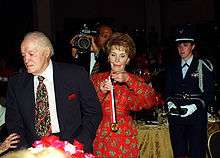
Hope was awarded more than 2,000 honors and awards, including 54 honorary university doctorates. In 1963 President John F. Kennedy awarded him the Congressional Gold Medal for service to his country.[137] President Lyndon Johnson bestowed the Presidential Medal of Freedom in 1969 for his service to the armed forces through the USO.[138] In 1982 he received the S. Roger Horchow Award for Greatest Public Service by a Private Citizen, an honor given annually by Jefferson Awards.[139] He was presented with the National Medal of Arts in 1995[140] and received the Ronald Reagan Freedom Award in 1997.[141] On June 10, 1980, he became the 64th—and only civilian—recipient of the United States Air Force Order of the Sword which recognizes individuals who have made significant contributions to the enlisted corps.[142]
Several buildings and facilities were renamed for Hope, including the historic Fox Theater in downtown Stockton, California,[143] and the Bob Hope Airport in Burbank, California.[144] There is a Bob Hope Gallery at the Library of Congress.[145] In memory of his mother, Avis Townes Hope, Bob and Dolores Hope gave the Basilica of the National Shrine of the Immaculate Conception in Washington, D.C., a chapel called the Chapel of Our Lady of Hope.[146] USNS Bob Hope (T-AKR-300) of the U.S. Military Sealift Command was named for the performer in 1997. It is one of very few U.S. naval ships that were named after living people.[147] The Air Force named a C-17 Globemaster III transport aircraft the Spirit of Bob Hope.[148]
In 1965, he was awarded an honorary Doctor of Humane Letters (L.H.D.) degree from Whittier College.[149]
In 1978 Hope was invited to dot the "i" in the Ohio State University Marching Band's "Script Ohio" formation, an honor only given to non-band members on 14 occasions from 1936 through 2016.[150] The New York Times, 5-8-79, p. C 7, stated that Woody Allen wrote and narrated a documentary honoring him, My Favorite Comedian, shown at Lincoln Center. In Hope's hometown of Cleveland, the refurbished Lorain-Carnegie Bridge was renamed the Hope Memorial Bridge in 1983, though differing claims have been made as to whether the bridge honors Hope himself, his entire family, or his stonemason father who helped in the bridge's construction. Also, East 14th Street near Playhouse Square in Cleveland's theater district was renamed Memory Lane-Bob Hope Way in 2003 in honor of the entertainer's 100th birthday.[151]
In 1992 Hope was honored with the "Lombardi Award of Excellence" from the Vince Lombardi Cancer Foundation. The award was created to honor the football coach's legacy, and is awarded annually to an individual who exemplifies his spirit. On May 28, 2003, President George W. Bush established the Bob Hope American Patriot Award.[152]
Academy Awards
Although he was never nominated for a competitive Oscar, Hope was given five honorary awards by the Academy of Motion Picture Arts and Sciences:[153]
- 13th Academy Awards (1940): Special Award in recognition of his unselfish services to the motion picture industry
- 17th Academy Awards (1944): Special Award for his many services to the Academy
- 25th Academy Awards (1952): Honorary Award for his contribution to the laughter of the world, his service to the motion picture industry, and his devotion to the American premise
- 32nd Academy Awards (1959): Jean Hersholt Humanitarian Award
- 38th Academy Awards (1965): Honorary Award for unique and distinguished service to the industry and the Academy
Discography
Singles
| Year | Single | US Pop Chart[154] |
|---|---|---|
| 1936 | "De-Lovely" (eponym of 2004 film biography of Cole Porter) | -- |
| 1938 | "Thanks for the Memory" (Oscar for Best Original Song) (Bob Hope and Shirley Ross) | -- |
| 1939 | "Two Sleepy People" (B-side) (Bob Hope and Shirley Ross) | 15 |
| 1945 | "(We're Off on the) Road to Morocco" (Bing Crosby and Bob Hope) | 21 |
| 1948 | "Buttons and Bows" (Oscar for Best Original Song) | -- |
| 1950 | "Blind Date" (Margaret Whiting and Bob Hope) | 16 |
| 1951 | "Silver Bells (Christmas song) | -- |
Bibliography
See also
- Bob Hope television specials
References
- At the time of his birth, Eltham had been part of the County of London since 1900
- Zoglin, Richard (November 30, 2017). "This Is Bob Hope… Biography". PBS. Archived from the original on May 14, 2018. Retrieved May 13, 2018.
- "Committee Reports: 105th Congress (1997–1998): House Report 105-109". Library of Congress. Archived from the original on October 8, 2014. Retrieved August 3, 2012.
- "Bob Hope birthplace for sale". news.bbc.co.uk. Retrieved May 10, 2018.
- "Bob Hope - from Eltham to Hollywood". www.newsshopper.co.uk. Archived from the original on May 11, 2018. Retrieved May 10, 2018.
- "Plaque: Bob Hope". www.londonremembers.com. Archived from the original on May 11, 2018. Retrieved May 10, 2018.
- "Barry Ideas Bank". Crowdicity. Archived from the original on June 20, 2017. Retrieved February 2, 2016.
- Moreno 2008, p. 88.
- Grudens 2002, p. 4.
- "Bob Hope and the American Variety: Early Life". Library of Congress. May 10, 2000. Archived from the original on October 15, 2012. Retrieved August 3, 2012.
- "Boys' Industrial School". Ohio Historical Society. July 1, 2005. Archived from the original on June 28, 2011. Retrieved August 7, 2011.
- "Bob Hope". Boxing-scoop.com. Archived from the original on July 23, 2012. Retrieved April 11, 2012.
- White, Timothy (March 20, 1980). "Bob Hope Reflects on the Road Not Taken". Rolling Stone. Archived from the original on January 7, 2018. Retrieved January 6, 2018.
- Quirk 1998, pp. 19–23.
- Faith 2003, pp. 402–403.
- Quirk 1998, p. 44.
- Grudens 2002, pp. 15–16.
- "Bob Hope and American Variety: On the Road: USO Shows". Library of Congress. May 10, 2000. Archived from the original on January 4, 2014. Retrieved January 4, 2014.
- Quirk 1998, pp. 57–58.
- "Last Go-Round Recalls Legends of Famed Track : And Now, Riverside Roars Into History". Los Angeles Times. August 7, 1988. Archived from the original on January 13, 2020. Retrieved April 7, 2020.
- Quirk 1998, p. 229.
- "Bob Hope: King of the Oscars". Biography. Archived from the original on July 28, 2017. Retrieved July 19, 2017.
- Quirk 1998, pp. 318–320.
- Grudens 2002, pp. 181–182.
- Maltin 1972, p. 25.
- Quirk 1998, pp. 105, 107.
- Quirk 1998, pp. 110, 113.
- Lahr 1998.
- Grudens 2002, p. 133.
- Quirk 1998, p. 112.
- Quirk 1998, p. 128.
- Grudens 2002, pp. 174–180.
- Quirk 1998, p. 127.
- Quirk 1998, pp. 127, 137.
- Quirk 1998, p. 265.
- Quirk 1998, p. 287.
- Grudens 2002, p. 41.
- Quirk 1998, pp. 285–286.
- Grudens 2002, p. 154.
- McCaffrey 2005, p. 56.
- Nachman 1998, p. 144.
- Grudens 2002, pp. 30–32.
- Quirk 1998, pp. 92–103.
- "Raquel! (1970 TV Movie): Full Cast & Crew". IMDb. Retrieved December 27, 2016.
- "Archived copy". Archived from the original on August 6, 2011. Retrieved May 19, 2011.CS1 maint: archived copy as title (link)
- "Happy Birthday today to Raquel Welch: Her 1970 primetime TV special will melt your mind!". Archived from the original on April 11, 2019. Retrieved April 10, 2019.
- Grudens 2002, pp. 47–48.
- Grudens 2002, p. 160.
- Grudens 2002, p. 48.
- Friedrich 1986, p. 26.
- Grudens 2002, p. 113.
- King, Larry (August 27, 2003). "Interview Q&A between Hope-Smith and Z. Hope: Tribute to Bob Hope". Larry King Live. CNN Transcripts.
- Grudens 2002, pp. 251, 254, 258.
- Steinbeck 1958, p. 65.
- "1968 Sylvanus Thayer Award: Bob Hope". West Point Association of Graduates. Archived from the original on November 28, 2011. Retrieved August 6, 2012.
- Faith 2003, p. 429.
- "A salute for Stephen Colbert". Los Angeles Times. Eddy Hartenstein. June 13, 2009. Archived from the original on July 15, 2012. Retrieved August 16, 2012.
- Faith 2003, p. 403.
- Quirk 1998, p. 71.
- Quirk 1998, pp. 73–75.
- "Comedian Bob Hope opened in The Muny's production of Roberta". The Muny. June 16, 1958. Retrieved August 14, 2012.
- "Bob Hope's 100th Birthday". The Bob Hope Theatre. May 29, 2003. Archived from the original on February 22, 2012. Retrieved August 14, 2012.
- "The Simpsons: Lisa and the Beauty Queen". Fox Broadcasting Company. Archived from the original on July 5, 2012. Retrieved August 17, 2012.
- "Bob Hope: The First 90 Years: NBC". Academy of Television Arts and Sciences. Archived from the original on March 4, 2016. Retrieved August 17, 2012.
- Quirk 1998, p. 291.
- Errico, Marcus (October 23, 1996). "Bob Hope Liberated from NBC After 60 Years". E! Entertainment Television. Retrieved August 18, 2012.
- Seely, Mike (November 30, 2005). "Bob Hope's Laughing with the Presidents (1997)". The Riverfront Times. Village Voice Media Holdings. Retrieved August 17, 2012.
- Lorencz, Mary; Baldwin, Paula (October 23, 1997). "Kmart Launches Celebrity-Studded TV Ad Campaign for New Big Kmart". Press release. Sears Holdings Corporation. Archived from the original on June 6, 2013. Retrieved August 17, 2012.
- Quirk 1998, p. 158.
- Quirk 1998, pp. 123, 183.
- Quirk 1998, p. 153.
- Quirk 1998, p. 172.
- Quirk 1998, pp. 184, 187.
- Quirk 1998, p. 173.
- Harris, Mark (2008). Pictures at a Revolution. Penguin Press. p. 409.
- Quirk 1998, pp. 255, 276, 314.
- Grudens 2002, p. 161.
- Quirk 1998, p. 312.
- Grudens 2002, p. 57.
- McCarten, Barry (August 12, 2012). "History and Live Theatre in Winnipeg". The Manitoba Historical Society. Archived from the original on October 26, 2012. Retrieved August 31, 2012.
- West, Bob (May 31, 1980). "Bob Hope hooked for life by golf, Hughen students". The Port Arthur News. Roger Underwood. Archived from the original on July 18, 2010. Retrieved July 19, 2008.
- "Profile: Bob Hope". World Golf Hall of Fame. Archived from the original on October 21, 2013. Retrieved September 4, 2013.
- "New era dawns in California desert". Fox Broadcasting Company. January 18, 2012. Archived from the original on February 26, 2012. Retrieved August 10, 2012.
- "Tournament History". Bob Hope Chrysler Classic. Archived from the original on March 1, 2000. Retrieved August 17, 2012.
- "Humana Challenge Unveils Tournament Details and Structure at Media Day". Business Wire. December 6, 2011. Archived from the original on January 8, 2012. Retrieved August 10, 2012.
- "Bing Crosby Buys Chunk of Pirates As Club Sold to New Owners' Group". Windsor Daily Star. August 9, 1946. p. Second section, p. 3.
- Rea, Steven X (August 21, 1982). "Why Bob Hope's Still on the Road". Montreal Gazette. Alan Allnutt. p. E–1. Retrieved August 10, 2012.
- "SI Vault: Bob Hope". Sports Illustrated. Turner Sports & Entertainment Digital Network. Archived from the original on January 24, 2013. Retrieved August 12, 2012.
- Dawidziak, Mark (May 29, 2003). "For our favorite son Bob Hope, all roads lead back home to Ohio". Cleveland Plain Dealer. Advance Publications. Archived from the original on June 7, 2011. Retrieved August 12, 2012.
- "Reeves Buys Rams For $4.8 Million". Lodi News-Sentinel. Marty Weybret. December 28, 1962. p. 9.
- "FWAA Names 2009 All-American Team". Football Writers Association of America. December 12, 2009. Archived from the original on January 20, 2010. Retrieved August 12, 2012.
- "Pennsylvania, County Marriages, 1885-1950," database with images, FamilySearch (https://familysearch.org/ark:/61903/1:1:VFQR-NPT), William H Hope in entry for Leslie T Hope and Grace L Troxell, January 25, 1933; citing Marriage, Pennsylvania, county courthouses, Pennsylvania; FHL microfilm 2,259,873.
- Quirk 1998, p. 66.
- Sheridan, Peter (August 16, 2014). "Bob Hope the Bigamist". Daily Express. Archived from the original on August 16, 2014. Retrieved August 16, 2014.
- The Scranton Republican, Scranton, Pennsylvania, Monday, April 27, 1931, p. 4
- The Brooklyn Daily Eagle, Brooklyn, New York, Wednesday, June 28, 1933, p. 35
- Eagle Brooklyn, New York, Saturday, July 14, 1933, p. 5
- Quirk 1998, pp. 86–87.
- "Anthony J. Hope, 63, Head Of Panel and Bob Hope's Son". The New York Times. Arthur Ochs Sulzberger, Jr. July 2, 2004. Archived from the original on June 10, 2012. Retrieved June 10, 2012.
- 1940 US Census via Ancestry.com
- Quirk 1998, pp. 82, 90.
- O'Dowd 2006, p. 65.
- O'Dowd 2006, pp. 66, 67.
- O'Dowd 2006, p. 311.
- O'Dowd 2006, p. 313.
- Marx, Arthur (1993). The Secret Life of Bob Hope: An Unauthorized Biography. Fort Lee, New Jersey: Barricade Books. ISBN 978-0-942637-74-8.
- Lumenick, Lou (October 31, 2014). ""Bob Hope, sex machine, "often cheated" during his 69-year marriage". New York Post. Archived from the original on January 12, 2020. Retrieved January 23, 2020.
- Gilbey, Ryan (March 6, 2020). "Greg Kinnear on Misbehaviour and #MeToo: 'Where were human resources in the 1990s?'". The Guardian. ISSN 0261-3077. Archived from the original on March 8, 2020. Retrieved March 8, 2020.
- "History: Fight for Sight Leaders: Lights On Fundraiser, Celebrity Supporters". Fight for Sight. Archived from the original on March 27, 2012. Retrieved August 14, 2012.
- Wilson, Earl (April 14, 1971). "Sergio Franchi & Yvonne de Carlo featured at "Fight for Sight" Benefit". The Milwaukee Sentinel. Milwaukee, WI: Elizabeth Brenner.
- Rosen, Jody (June 25, 2019). "Here Are Hundreds More Artists Whose Tapes Were Destroyed in the UMG Fire". The New York Times. Archived from the original on November 23, 2019. Retrieved June 28, 2019.
- "A Masterpiece of Murder (1896)". Turner Classic Movies. Archived from the original on June 7, 2013. Retrieved August 16, 2012.
- "The Bob Hope Show: Happy Birthday, Bob!". CBS Corporation. Archived from the original on March 25, 2013. Retrieved August 16, 2012.
- "History of Past Honorees". Kennedy Center for the Performing Arts. Archived from the original on December 9, 2008. Retrieved August 16, 2012.
- Ward, Linda. "Bob Hope: Thanks for the memory". Canadian Broadcasting Corporation. Archived from the original on November 8, 2012. Retrieved August 16, 2012.
- "Archived copy". Archived from the original on July 28, 2018. Retrieved July 27, 2018.CS1 maint: archived copy as title (link)
- Gallo, Phil (September 12, 1998). "The 50th Annual Primetime Emmy Awards". Variety. Reed Business Information. Retrieved August 16, 2012.
- "Hope for America: Performers, Politics and Pop Culture". Library of Congress. Archived from the original on July 29, 2012. Retrieved August 16, 2012.
- "Bob Hope and American Variety". Library of Congress. May 10, 2000. Archived from the original on November 3, 2012. Retrieved August 16, 2012.
- Spander, Art (May 28, 2003). "Hope left golf laughing all the way to the bank". Archived from the original on November 18, 2018. Retrieved April 7, 2020 – via www.telegraph.co.uk.
- "Bob Hope's 100th birthday greeted with good wishes". USA Today. Gannett Company. Associated Press. May 30, 2003. Archived from the original on March 18, 2016. Retrieved November 16, 2012.
- "Comedian Bob Hope dies". BBC News. July 28, 2003. Archived from the original on October 23, 2012. Retrieved August 18, 2012.
- "St. Charles Catholic Church". Gary Wayne. Archived from the original on August 26, 2012. Retrieved August 16, 2012.
- House Session. C-SPAN. June 5, 1998. Event occurs at 6:01:45. Archived from the original on October 18, 2012. Retrieved July 15, 2012.
- Quirk 1998, p. 313.
- Grudens 2002, p. 148.
- "Bob Hope released from hospital". CNN. June 7, 2000. Archived from the original on October 1, 2012. Retrieved August 18, 2011.
- "Bob Hope stays in hospital". The Guardian. Guardian News and Media. September 4, 2001. Archived from the original on May 9, 2014. Retrieved August 7, 2011.
- O'Brien, Soledad (July 29, 2003). "Hope grandson: Laughter until the end". CNN. Archived from the original on November 7, 2012. Retrieved August 7, 2011.
- "Bob Hope buried after private funeral". Sioux City Journal. Archived from the original on September 17, 2018. Retrieved April 7, 2020.
- Doyle, Paula (August 23, 2005). "Bob Hope Memorial Garden opens at San Fernando Mission". Catholic News Service. Archived from the original on August 24, 2005. Retrieved August 13, 2012.
- "In Memory of Bob Hope". Forward Air Controllers Association. Archived from the original on July 19, 2012. Retrieved June 10, 2012.
- Kendall, Mary Clark. "Bob Hope and His Ladies of Hope". Forbes. Archived from the original on November 24, 2016. Retrieved January 23, 2020.
- Higgins, Michelle (February 25, 2013). "Bob Hope Estate in Palm Springs Is Up for Sale". The New York Times. Archived from the original on February 27, 2013. Retrieved February 25, 2013.
- Mikailian 2012.
- Chiland, Elijah (November 15, 2016). "Bob Hope's Lautner-designed Palm Springs home finally finds a buyer". Curbed LA. Archived from the original on November 12, 2019. Retrieved April 7, 2020.
- Grudens 2002, pp. 152–153.
- "Great American Patriot Bob Hope". USA Patriotism. Archived from the original on July 17, 2011. Retrieved August 7, 2011.
- "National Winners: Public service awards". Jefferson Awards.org. Jefferson Awards for Public Service. Archived from the original on November 24, 2010. Retrieved August 2, 2013.
- "Lifetime Honors: 1995". National Endowment for the Arts. Archived from the original on July 21, 2011. Retrieved August 13, 2012.
- "Hope Gets Freedom Award". Times-Union. Warsaw, Indiana. May 30, 1997. Retrieved August 14, 2012.
- "Members of the Order of the Sword". Maxwell-Gunter Air Force Base, Montgomery, Alabama: Air University. Archived from the original on September 30, 2011. Retrieved August 16, 2012.
- "Durkan Plays the Supporting Role in the Restoration of Bob Hope Theater" (PDF). The Mohawk Group. Archived from the original (PDF) on December 14, 2011. Retrieved August 15, 2012.
- Castro, Tony (June 1, 2010). "Burbank airport honors namesake". Los Angeles Daily News. Jack Klunder. Archived from the original on April 17, 2013. Retrieved August 15, 2012.
- "Bob Hope Gallery" Archived September 19, 2015, at the Wayback Machine. Retrieved July 14, 2015.
- Mary Claire Campbell, "Bob Hope and His Ladies of Hope: His Mother, Wife and Our Lady of Hope Made All the Difference in His Life", October 19, 2011, Archived June 17, 2018, at the Wayback Machine. Retrieved July 14, 2015.
- "T-AKR USNS Bob Hope Large, Medium-speed, roll-on/roll-off ships [LMSR]". Federation of American Scientists. 2011. Archived from the original on September 20, 2012. Retrieved August 15, 2012.
- "Boeing C-17 Dedicated to the Spirit of Medal of Honor". Warplanes Online Community. Archived from the original on June 23, 2013. Retrieved August 15, 2012.
- "Honorary Degrees | Whittier College". www.whittier.edu. Archived from the original on January 10, 2020. Retrieved December 6, 2019.
- "Nicklaus to dot the I on Saturday". October 26, 2006. Archived from the original on August 27, 2017. Retrieved August 27, 2017.
- "Ohio remembers Bob Hope's roots on his 100th birthday". Archived from the original on August 22, 2016. Retrieved July 26, 2016.
- Office of the Press Secretary (June 3, 2003). "Establishing the Bob Hope American Patriot Award". Federal Register. Washington, D.C.: Federal Government of the United States. Archived from the original on May 2, 2017. Retrieved April 9, 2017.
- "Academy Awards Database". Academy of Motion Pictures Arts & Sciences. Archived from the original on October 29, 2013. Retrieved August 18, 2012.
- Whitburn, Joel (1986). Pop Memories: 1890-1954. Record Research.
Bibliography
- Faith, William Robert (2003). Bob Hope: A Life in Comedy. Cambridge, MA: Da Capo Press. ISBN 978-0-306-81207-1.CS1 maint: ref=harv (link)
- Friedrich, Otto (1986). City of Nets: A Portrait of Hollywood in 1940s. Berkeley; Los Angeles: University of California Press. ISBN 978-0-520-20949-7.CS1 maint: ref=harv (link)
- Grudens, Richard (2002). The Spirit of Bob Hope: One Hundred Years, One Million Laughs. Sioux Falls, SD: Pine Hill Press. ISBN 978-1-57579-227-9.CS1 maint: ref=harv (link)
- Lahr, John (December 21, 1998). "Profiles: The CEO of Comedy". The New Yorker: 62–79.CS1 maint: ref=harv (link)
- Maltin, Leonard (1972). The Great Movie Shorts. New York: Da Capo Press. ISBN 978-0-517-50455-0.CS1 maint: ref=harv (link)
- McCaffrey, Donald W. (2005). The Road to Comedy: The films of Bob Hope. Westport, CT: Praeger. ISBN 978-0-275-98257-7.CS1 maint: ref=harv (link)
- Mikailian, Arin (December 5, 2012). "Bob Hope's Toluca Lake Home Hitting the Market". North Hollywood-Toluca Lake Patch. Retrieved June 8, 2013.CS1 maint: ref=harv (link)
- Moreno, Barry (2008). Ellis Island's Famous Immigrants. Charleston, SC: Arcadia. ISBN 978-0-7385-5533-1.CS1 maint: ref=harv (link)
- Nachman, Gerald (1998). Raised on Radio. New York: Pantheon Books. ISBN 978-0-375-40287-6.CS1 maint: ref=harv (link)
- O'Dowd, John (2006). Kiss Tomorrow Goodbye: The Barbara Payton Story. Albany, GA: Bear Manor Media. ISBN 978-1-59393-063-9.CS1 maint: ref=harv (link)
- Quirk, Lawrence J. (1998). Bob Hope: The Road Well-Traveled. New York: Applause. ISBN 978-1-55783-353-2.CS1 maint: ref=harv (link)
- Steinbeck, John (1958). Once There Was A War. New York: Viking Press. OCLC 394412.CS1 maint: ref=harv (link)
Further reading
- Mills, Robert L. (2009). The Laugh Makers: A Behind the Scenes Tribute to Bob Hope's Incredible Gag Writers. Albany, GA: Bear Manor Media. ISBN 978-1-59393-323-4.
- Wilde, Larry (2000). The Great Comedians Talk About Comedy. Executive Books. ISBN 978-0-937539-51-4.
- Young, Jordan R. (1999). The Laugh Crafters: Comedy Writing in Radio and TV's Golden Age. Beverly Hills, CA: Past Times Publishing. ISBN 978-0-940410-37-4.
- Zoglin, Richard (2014). Hope: Entertainer of the Century. New York: Simon & Schuster. ISBN 978-1-4391-4858-7.
External links
| Wikiquote has quotations related to: Bob Hope |
| Wikimedia Commons has media related to Bob Hope. |
- Bob Hope at the Encyclopædia Britannica
- Bob Hope at AllMovie
- Bob Hope at the Internet Broadway Database

- Bob Hope on IMDb
- Bob Hope at the TCM Movie Database
- Bob Hope at the National Radio Hall of Fame
- MSNBC tribute series:
- Congressional Gold Medal Recipients
- Literature on Bob Hope
- Law making Bob Hope an honorary veteran
- National Press Club Luncheon Speakers, Bob Hope, July 8, 1980
- article "Bob Hope And The Holocaust: No Laughing Matter (The David S. Wyman Institute for Holocaust Studies) - praise "took real political courage"